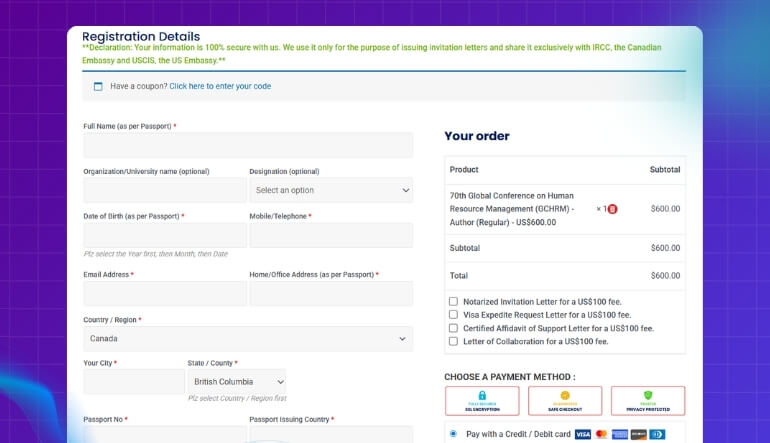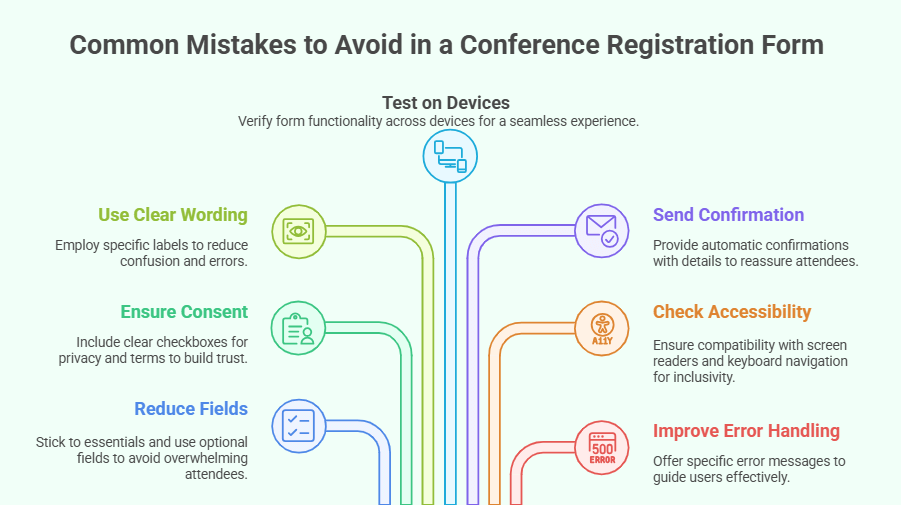What should be included in a conference registration form? It’s a question every event organizer faces while preparing to welcome participants. A registration form is often the first direct interaction attendees have with your conference, and the way it’s structured can shape their entire experience.
The answer lies in keeping the form simple yet complete. Essential fields like attendee details, ticket type, payment options, and special requirements ensure smooth processing, while optional sections such as dietary preferences or workshop choices make the event more personalized. A well-built form not only collects information but also creates a professional first impression.
In this article, you’ll discover exactly which elements turn a registration form into a smooth, engaging experience. We’ll walk through practical tips, proven strategies, and real-world examples that help you design a form attendees actually enjoy filling out.
What Should Be Included in a Conference Registration Form?
A conference registration form is the first real step where attendees connect with your event. If it’s done right, it sets a positive tone by collecting the right details clearly and efficiently. Here’s a breakdown of what every good registration form should include.

Basic Personal Information
Every form begins with essentials like full name, email, and phone number. Adding organization, job title, or country helps organizers identify participants properly and prepare badges. Getting these details correct ensures smooth check-in and clear communication before and during the conference.
Professional Background
Asking about industry, role, or expertise helps organizers understand the type of audience attending. This data is valuable for shaping sessions, building networking opportunities, and grouping participants with similar interests. A short background question provides context and helps you deliver a more tailored conference experience.
Session and Workshop Preferences
When an event offers multiple tracks or workshops, attendees should select their choices while registering. This gives organizers insight into room capacity and popular topics, helping avoid overcrowding. For participants, it guarantees access to sessions they truly value and saves last-minute stress on the event day.
Dietary Preferences and Restrictions
Food is a key part of many conferences, and dietary questions avoid awkward issues. Options such as vegetarian, vegan, gluten-free, or allergy-specific choices make planning easier. Gathering this early ensures meals are safe, inclusive, and enjoyable for everyone without the risk of mistakes or overlooked needs.
Accessibility and Special Accommodations
Every attendee deserves to feel welcome and supported. Asking about accessibility needs such as mobility assistance, sign language interpretation, or reserved seating ensures you can plan ahead. In larger international events, including conferences in Canada, the USA, or the UK, these details are especially important for offering equal access and a meaningful experience.
Payment and Ticket Options
For paid conferences, the form should include ticket selection, payment methods, and promo code options. Adding billing information like company name and invoice address is helpful for business attendees. This keeps the financial side transparent, straightforward, and avoids unnecessary follow-up later on.
Merchandise or Swag Preferences
If your event offers t-shirts, tote bags, or notebooks, it’s smart to let attendees choose in advance. Collecting t-shirt sizes or item preferences during registration prevents waste, avoids disappointment on-site, and ensures participants actually receive something that’s useful and the right fit.
Travel Details (Optional)
For international or large events, knowing arrival dates, flight times, or hotel preferences can save headaches. This information helps organizers coordinate airport shuttles, plan welcome desks, or share last-minute updates. While not mandatory, it’s a practical way to simplify travel arrangements for attendees.
Emergency Contact
A simple but important addition is an emergency contact. Asking for a name, phone number, and relationship provides a safety net in case of unexpected situations. Even though it’s rarely used, having it ensures peace of mind for both attendees and organizers.
Consent and Agreements
Modern registration forms include consent checkboxes for clarity and compliance. Typical items are agreement to terms and conditions, acknowledgment of refund policy, privacy and data use, optional photo/video consent, and a marketing opt-in. These small but critical steps build trust and protect both parties legally.
Sample Structure (Quick Example)
Here’s a simplified outline you can adapt into a basic form:
- Full Name
- Email Address
- Phone Number
- Organization / Job Title
- Session Preferences (checklist)
- Dietary Needs (drop-down options)
- Accessibility Requirements (open field)
- Ticket Type & Payment Information
- Emergency Contact (Name + Phone)
- Agree to Terms & Conditions [Check Box]
- Acknowledge Privacy Policy [Check Box]
Your registration form for conference events doesn’t need to be complicated; it just needs to be thoughtful. Collecting these details ensures smoother planning, fewer surprises, and happier attendees. By balancing required fields with optional extras, you create a clear, welcoming start to your event.
Consent & Compliance
A registration form isn’t only about collecting names and preferences—it also needs to cover legal and trust factors. Clear consent options make attendees feel safe while protecting organizers from problems later. Adding these points builds confidence and shows professionalism. Let’s look at the essentials.
GDPR and Privacy Consent
Always include a checkbox that links to your privacy policy. This tells attendees how their personal data will be stored and used. Keeping the wording simple and transparent shows respect for their information and avoids misunderstandings.
Photo and Video Consent
Many conferences record sessions or take event photos. Asking for photo/video consent gives participants the choice to opt in or out. It avoids disputes later and lets you use media for promotion or archives without any confusion.
Terms & Conditions / Refund Policy Acknowledgment
A quick acknowledgment checkbox ensures attendees agree to the event’s terms. This includes refund rules, cancellation policies, and participation guidelines. It keeps everyone on the same page and prevents arguments over payments or last-minute changes.
Marketing Opt-in (Unchecked by Default)
Offer attendees the choice to join your mailing list, but keep the box unchecked by default. This way, only those genuinely interested in updates or future events will subscribe, keeping your communications cleaner and more effective.
Consent and compliance fields may seem small, but they carry big importance. They protect your event legally, respect attendee preferences, and create trust. By including them clearly in your form, you make the registration process both professional and reassuring.
Payments and Invoicing
Handling payments through a registration form should be smooth and simple. If attendees find it confusing, they may delay signing up or leave the form halfway. By setting clear options, you make the process faster and more transparent. Here are the essentials to include.
Ticket Types
Offer different ticket categories, such as early bird, standard, student, or VIP. Each option should show the price clearly so attendees can make quick decisions. Adding short descriptions also helps them pick the ticket that best fits their needs, especially when a standard conference registration fee applies.
Discounts and Promo Codes
Promo codes are a great way to reward early registrants, returning attendees, or special groups. Add a small field in the form for discounts. Make sure it’s simple to use and clearly states how much the code reduces the final cost.
Invoicing Details
Business attendees often need an invoice with proper details. Include fields for company name, billing address, and tax or VAT numbers where applicable. Having this information upfront avoids back-and-forth emails and ensures companies can process payments smoothly.
Payments and invoicing might feel like technical details, but they directly affect how easy the conference registration process is for attendees. With clear ticket options, simple discount fields, and proper billing details, you make the process painless and professional for every attendee.
Form UX That Boosts Completion
A registration form should feel simple to fill out, not like a long and tiring task. The way the form is designed directly affects whether attendees finish it or leave halfway. A few thoughtful choices can make a big difference. Let’s walk through the most helpful ones.
Multi-step Forms With Progress Bar
Breaking a long form into smaller steps keeps people from feeling overwhelmed. A progress bar at the top shows them how far they’ve come and how much is left. This small visual guide motivates users to keep going until the end.
Conditional Logic (only show what’s needed)
Nobody likes answering questions that don’t apply to them. By using conditional logic, the form displays only the fields relevant to each attendee. For example, billing details appear only if someone selects a paid ticket, making the experience cleaner and faster.
Inline Validation
Inline validation checks the information while the attendee types. If an email is missing the “@” symbol or a phone number isn’t long enough, the form highlights it right away. This prevents errors from piling up and saves time at submission, helping more people successfully register for conference events.
Mobile-first, Responsive Design
Many people register from their phones, so the form must adapt well to small screens. Clear fonts, big enough touch areas, and simple layouts ensure that the form works just as smoothly on a smartphone as it does on a laptop. A well-structured conference registration page should always be built with this flexibility in mind.
Good form design doesn’t just look nice; it makes the registration process easier and faster. By applying these simple UX tips, you’ll create a form that more people complete without frustration, leading to higher registrations and happier attendees.
Importance of a Conference Registration Form
A registration form may seem like a small detail, but it plays a big role in shaping how smoothly a conference runs. It’s not just about collecting names; it’s about gathering the right details to plan ahead. Here’s why it matters.
- Helps Organizers Stay Organized: Having personal, professional, and contact details in one place makes it easier to manage attendee lists, prepare badges, and handle communication without confusion. This planning also connects with choosing the best time to open conference registration, so nothing feels rushed.
- Supports Better Planning: Information like session preferences, dietary needs, and accessibility requests ensures that spaces, meals, and resources are arranged properly. This prevents last-minute issues and helps attendees feel cared for.
- Improves Safety and Trust: Details such as emergency contacts and consent agreements give both attendees and organizers peace of mind. It shows the event is professionally managed and committed to responsibility.
- Boosts Attendee Experience: When forms are clear and complete, participants spend less time sorting out details later. This smooth process creates a welcoming impression before the event even begins.
The conference registration form serves as the first step in shaping how participants experience your event. Collecting the right details not only streamlines planning but also ensures attendees feel welcomed and well-prepared from the start.
Common Mistakes to Avoid in a Conference Registration Form
A registration form should be quick and easy to complete, but sometimes small mistakes can turn it into a frustrating process. If organizers overlook certain details, it can slow down sign-ups or even cause people to drop off. Let’s look at the most common slip-ups and how to avoid them.
Mistake: Overloading with Fields
Solution: Stick to the essentials like personal details, sessions, and payment. Place extras under optional fields or break the form into smaller steps so attendees don’t feel buried in questions.
Mistake: Ignoring Consent and Privacy
Solution: Always include checkboxes for terms, refund policies, privacy policies, and data use. Provide direct links and clear wording so people feel comfortable sharing their information.
Mistake: Unclear Wording
Solution: Use specific, simple labels such as “Dietary Restrictions” instead of vague terms like “Other Information.” Clear language reduces mistakes and makes the form less intimidating.
Mistake: Not Testing Across Devices
Solution: Test the form on phones, tablets, and desktops before launch. Make sure it looks good, loads quickly, and is easy to complete on smaller screens.
Mistake: No Confirmation or Follow-Up Email
Solution: After submission, send an automatic confirmation with event details, payment receipt (if applicable), and contact info. This reassures attendees and avoids confusion later.
Mistake: Skipping Accessibility Checks
Solution: Ensure forms work with screen readers, have proper color contrast, and allow keyboard navigation. An accessible form shows inclusivity and prevents you from losing attendees with special requirements.
Mistake: Poor Error Handling
Solution: Instead of vague red warnings like “Invalid,” tell users what to fix -“Please enter a valid email address.” Clear instructions reduce frustration and prevent drop-offs.
Avoiding these mistakes makes your form smoother, more secure, and more welcoming. A little extra attention to detail can turn clumsy conference registrations into streamlined experiences that attendees find quick, easy, and reliable.
Frequently Asked Questions
People often have follow-up doubts once they finish reading about conference registration forms. These are the kind of practical questions that come up again and again. To make things easier, here are some common ones with clear answers.
Can I Edit My Information After Submitting the Form?
Yes, most organizers allow small edits if you contact them early. Some forms even include a direct “edit registration” link in the confirmation email. Always double-check your details before final submission to avoid delays.
Do Organizers Share My Personal Information With Others?
Your details are typically kept private and used only for the event. Organizers may share basic info like your name or company for networking lists. For anything beyond that, a privacy policy should clearly explain usage.
What Happens If I Lose My Confirmation Email?
Don’t panic, organizers usually keep a full attendee list. You can contact their support team with your name and email to retrieve your details. It’s still smart to save the confirmation email somewhere safe.
Can I Register a Group of Attendees in One Form?
Yes, many conferences provide a group registration option. This lets you add multiple participants under a single payment or invoice. It’s useful for teams and avoids repeating the form for each person.
How Are Special Requests Handled After Submission?
If you forgot to mention a dietary need or accessibility request, you can often email the event team directly. Early notice helps them plan better. Last-minute requests may be harder to accommodate, so act quickly.
Are Refunds Always Guaranteed If I Cancel?
Not always, refund policies vary by event. Some offer full refunds up to a certain date, while others give partial refunds or credits. Always read the refund policy carefully before completing your registration to avoid surprises later.
Will I Receive Any Updates After Registering?
Yes, organizers usually send updates by email, including reminders, schedule changes, or venue details. Some even provide a mobile app with notifications. Be sure your email is correct and check your spam folders so you don’t miss important updates.
Concluding Words
So, it’s clear that a registration form is much more than a sign-up sheet. It’s the very first interaction between attendees and organizers, setting expectations and creating a smooth start before the event even begins.
When thinking about what should be included in a conference registration form, the focus should be on balance. Collect the information you truly need, while keeping the process quick and stress-free for participants. Simple, clear, and well-structured fields make all the difference.
Finally, the details you gather early will help with planning, reduce confusion, and improve the attendee experience. By building a thoughtful form, you’re not just collecting names—you’re laying the groundwork for a successful and memorable conference.







